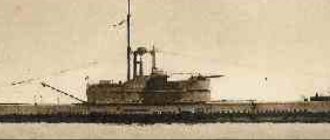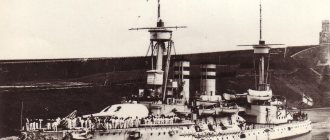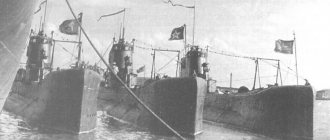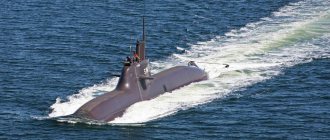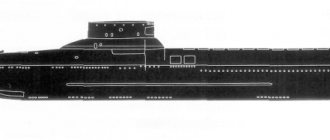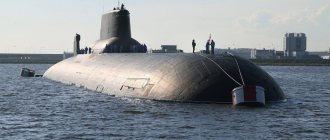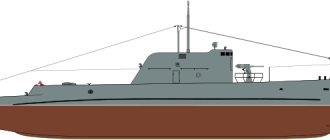Naval crimes
The first thing that comes to mind when talking about German submariners is their war crimes. They are usually blamed for sinking civilian ships and shooting passengers trying to escape. The Nuremberg Tribunal, trying to convict the Commander-in-Chief of the German Navy, Karl Dönitz, quoted his order of September 1942: “It is prohibited to make any attempts to rescue the crews of sunken ships and vessels, that is, to catch drowning people, transfer them to lifeboats, return overturned boats to their normal position , supply the victims with food and water. Rescue is contrary to the very first rule of warfare at sea, which requires the destruction of enemy ships and their crews.”
Article on the topic “Striped naked, he killed himself.” Who kept Hitler's heirs in power?
But something went wrong: Dönitz was given only 10 years in prison. He still did not call for shooting people floundering in the water. But some of his officers got to this point with their own minds.
On March 13, 1944, the submarine U-852 sank the Greek steamer Peleus off the coast of Africa. Since the boat was carrying out a secret mission in those waters, its commander Heinz Wilhelm Eck ordered all survivors to be shot with machine guns. The submariners shot so-so: three Greeks survived and subsequently gave evidence.
After the end of the war, all members of the U-852 crew were taken to Germany and tried there by a court-martial. The commander, ship's doctor and first mate were shot. The chief mechanic received a life sentence, the navigator - 7 years.
Other cases of murders at sea did not come to trial. The reason is simple: by the end of the war, 32 out of 39 thousand German submariners were killed.
German quality
For a long time it was generally accepted that German submarines were head and shoulders above Russian, British and American ones. This is not always true. The German boats themselves, which bore the main burden of the war at sea, were no different from their “classmates” in other countries. Let’s compare the performance characteristics of the VII C series submarines (the one that “played the main role” in Wolfgang Petersen’s “Submarine”) with Soviet and British ones.
Air-sea battle. How an airship challenged a submarine to a duel Read more
USSR:
- Type: Shch
- Displacement: 706 tons
- Engine power: 1000 l/s
- Torpedo tubes: 6
- Speed underwater/surface: 11.6/14 mph
- Dive depth: 90 meters
- Autonomy: 20 days
Germany:
- Type: VII C
- Displacement: 871 tons
- Engine power: 750 l/s
- Torpedo tubes: 5
- Speed underwater/surface: 7.6/17 mph
- Dive depth: 100 meters
- Autonomy: 35 days
Great Britain:
- Type: S-class
- Displacement: 935 tons
- Engine power: 1300 l/s
- Torpedo tubes: 7
- Speed underwater/surface: 10/15 mph
- Dive depth: 110 meters
- Autonomy: 40 days
As you can see, there are no special qualitative advantages. Another thing is the large German ocean-going submarines of the XXI type, which were truly superior to everything that the Allies had at that time. However, they arrived too late. Only two boats of this type managed to go on combat patrols before the end of the war. They had no influence on the course of hostilities.
Article on the topic
Damn cruiser. The true story of the sinking of the USS Indianapolis
Submarines | Germany
Submarine "U-25"
Submarine "U-26"
Large submarines of the 1st series “U-25” and “U-26” were built at the Deschimag shipyard and commissioned in 1936. Both boats were lost in 1940. Performance characteristics of the boat: total surface displacement - 862 tons, underwater - 983 t.; length – 72.4 m, width – 6.2 m; height – 9.2 m; draft – 4.3 m; immersion depth – 100 m; power plants – 2 diesel engines and 2 electric motors; power – 3.1/1 thousand hp; speed - 18.6 knots; fuel reserve - 96 tons of diesel fuel; cruising range - 7.9 thousand miles; crew - 43 people. Armament: 1x1 - 105 mm gun; 1x1 – 20 mm anti-aircraft gun; 4-6– 533 mm torpedo tubes; 14 torpedoes or 42 mines.
Submarine "U-37"
Submarine "U-41"
The series of large ocean-going submarines of the IX-A type consisted of 8 units (U-37 - U-44), built at the Deschimag shipyard and commissioned in 1938-1939. All boats were lost during the war. Performance characteristics of the boat: total surface displacement - 1 thousand tons, underwater displacement - 1.2 thousand tons; length – 76.5 m, width – 6.5 m; draft – 4.7 m; immersion depth – 100 m; power plants – 2 diesel engines and 2 electric motors; power – 4.4/1 thousand hp; speed – 18 knots; fuel reserve - 154 tons of diesel fuel; cruising range - 10.5 thousand miles; crew - 48 people. Armament: 1x1 - 105 mm gun, 1x1 - 37 mm and 1x1 - 20 mm anti-aircraft gun; 6 – 533 mm torpedo tubes; 22 torpedoes or 66 min.
Submarine "U-124"
Submarine "U-107"
Submarine "U-103"
Submarine "U-64"
The series of large ocean-going submarines of the "IX-B" type consisted of 14 units ("U-64" - "U-65", "U-103" - "U-124"), built at the Deschimag shipyard and accepted into service. construction in 1939-1940 All boats were lost during the war. Performance characteristics of the boat: total surface displacement - 1.1 thousand tons, underwater displacement - 1.2 thousand tons; length – 76.5 m, width – 6.8 m; draft – 4.7 m; immersion depth – 100 m; power plants – 2 diesel engines and 2 electric motors; power – 4.4/1 thousand hp; speed – 18 knots; fuel reserve – 165 tons of diesel fuel; cruising range - 12 thousand miles; crew - 48 people. Armament: 1x1 - 105 mm gun, 1x1 - 37 mm and 1x1 - 20 mm anti-aircraft gun; 6 – 533 mm torpedo tubes; 22 torpedoes or 66 min.
Submarine "U-166"
Submarine "U-510"
Submarine "U-505"
Submarine "U-171"
The series of medium-sized submarines of the "IX-C" type consisted of 54 units ("U-66" - "U-68", "U-125" - "U-131", "U-153" - "U-166" , “U-171” - “U-176”, “U-501” - “U-524”), built at the Deschimag shipyard and commissioned in 1941-1942. 48 boats were lost during the war, 3 were sunk by their crews, the rest capitulated. Performance characteristics of the boat: total surface displacement - 1.1 thousand tons, underwater displacement - 1.2 thousand tons; length – 76.8 m, width – 6.8 m; draft – 4.7 m; immersion depth – 100 m; power plants – 2 diesel engines and 2 electric motors; power – 4.4/1 thousand hp; speed – 18 knots; fuel reserve - 208 tons of diesel fuel; cruising range - 13.5 thousand miles; crew - 48 people. Armament: before 1944, 1x1 - 105 mm, 1x1 - 37 mm and 1x1 - 20 mm anti-aircraft gun; after 1944 - 1x1 - 37 mm and 1x4 or 2x2 - 20 mm anti-aircraft guns; 6 – 533 mm torpedo tubes; 22 torpedoes or 66 min.
Submarine "U-167"
Submarine "U-188"
Submarine "U-865"
Submarine "U-889"
The series of medium submarines of the IX-C/40 type consisted of 87 units (“U-167” - “U-170”, “U-183” - “U-194”, “U-525” - “U- 550", "U-801" - "U-806", "U-841" - "U-846", "U-853" - "U-858", "U-865" - "U-870" , “U-881” - “U-887”, “U-889”, “U-1221” - “U-1235”), built at the Deschimag and Deutsche Werft shipyards and commissioned in 1942- 1944 During the war, 64 boats were lost, 3 were sunk by their crews, 17 capitulated, the rest were damaged and were not repaired. Performance characteristics of the boat: total surface displacement - 1.1 thousand tons, underwater displacement - 1.3 thousand tons; length – 76.8 m, width – 6.9 m; draft – 4.7 m; immersion depth – 100 m; power plants – 2 diesel engines and 2 electric motors; power – 4.4/1 thousand hp; speed – 18 knots; fuel reserve - 214 tons of diesel fuel; cruising range - 13.9 thousand miles; crew - 48 people. Armament: 1x1 - 105 mm gun, 1x1 - 37 mm and 2x1 and 2x2 - 20 mm anti-aircraft gun; 6 – 533 mm torpedo tubes; 22 torpedoes or 66 min.
Submarine "U-195"
Submarine "U-848"
The medium submarines “U-180” and “U-195” belonged to the “IX-D” type - high-speed submarines. They were built at the Deschimag shipyard and commissioned in 1942. Since 1944, the boats have been converted into underwater transports. They transported 252 tons of diesel fuel. The U-180 boat was lost in 1944, and the U-195 was captured by Japanese troops in 1945 and served under the designation I-506. Performance characteristics of the boat: total surface displacement - 1.6 thousand tons, underwater displacement - 1.8 thousand tons; length – 87.6 m, height – 10.2 m; width – 7.5 m; draft - 5.4 m; immersion depth – 100 m; power plants – 6 diesel engines and 2 electric motors; power – 9/1.1 thousand hp; speed - 21 knots; fuel reserve - 390 tons of diesel fuel; cruising range - 9.5 thousand miles; crew - 57 people. Armament before 1944: 1x1 - 105 mm gun, 1x1 - 37 mm and 1x1 - 20 mm anti-aircraft gun; 6 – 533 mm torpedo tubes; 24 torpedoes or 72 minutes; after 1944 - 1x1 - 37 mm and 2x2 - 20 mm anti-aircraft guns.
Submarine "U-873"
Submarine "U-177"
Submarine "U-182"
The series of medium-sized submarines of the IXD-2 type consisted of 28 units (“U-177” - “U-179”, “U-181” - “U-182”, “U-196” - “U-200” , "U-847" - "U-852", "U-859" - "U-864", "U-871" - "U-876"), built at the Deschimag shipyard and commissioned in 1942 -1943 The boats were intended for operation in the South Atlantic and Indian Ocean. 21 boats were lost during the war, 1 was sunk by the crews, 7 capitulated. Performance characteristics of the boat: total surface displacement - 1.6 thousand tons, underwater displacement - 1.8 thousand tons; length – 87.6 m, width – 7.5 m; draft - 5.4 m; immersion depth – 100 m; power plants – 2 main diesel engines, 2 auxiliary diesel engines and 2 electric motors; power – 4.4+1.2/1 thousand hp; speed - 19 knots; fuel reserve - 390 tons of diesel fuel; cruising range - 31.5 thousand miles; crew - 57 people. Armament: 1x1 - 37 mm and 2x1 and 2x2 - 20 mm anti-aircraft gun; 6 – 533 mm torpedo tubes; 24 torpedoes or 72 mines. In 1943-1944, some boats were equipped with a towed FA-330 gyroplane.
Submarine "U-883"
Of the series of large submarines of the IX-D/42 type, only one submarine, U-883, was built at the Deschimag shipyard and commissioned in 1945. In the same year, the boat capitulated. During the construction process, it was repurposed for transport. The boat carried 252 tons of diesel fuel. Performance characteristics of the boat: total surface displacement - 1.6 thousand tons, underwater displacement - 1.8 thousand tons; length – 87.6 m, width – 7.5 m; draft - 5.4 m; immersion depth – 100 m; power plants – 2 main diesel engines, 2 auxiliary diesel engines and 2 electric motors; power – 4.4+1.2/1 thousand hp; speed - 19 knots; fuel reserve - 390 tons of diesel fuel; cruising range - 31.5 thousand miles; crew - 57 people. Armament: 1x1 - 37 mm and 2x2 - 20 mm anti-aircraft guns; 2 – 533 mm torpedo tubes; 5 torpedoes.
Submarines "U-2502", "U-3514" and "U-2518"
Submarine "U-3008"
The series of large submarines of type "XXI" consisted of 125 units ("U-2501" - "U-2531", "U-2533" - "U-2548", "U-2551", "U-2552", " U-3001" - "U-3044", "U-3047", "U-3501" - "U-3530") built at the shipyards "Blohm & Voss", "Deschimag" and commissioned in 1944-1945 . During the war, 21 boats were lost, 88 were sunk by their crews, and the rest capitulated to the Allies. Performance characteristics of the boat: total surface displacement - 1.6 thousand tons, underwater displacement - 1.8 thousand tons; length – 76.7 m, width – 8 m; draft – 6.3 m; diving depth – 135 m; power plants - 2 diesel engines, 2 main electric motors and 2 silent electric motors; power – 4/4.4 thousand hp + 226 hp; fuel reserve - 253 tons of diesel fuel; speed - 15.6 knots; cruising range - 15.5 thousand miles; crew - 57 people. Armament: 2x2 – 20 mm or 30 mm anti-aircraft gun; 6 - 533 mm torpedo tubes; 23 torpedoes or 29 min.
Submarine "U-27"
Submarine "U-29"
Submarine "U-36"
Submarine "U-35"
The series of medium submarines of the "VII-A" type consisted of 10 units ("U-27" - "U-36"), built at the Deschimag and Germaniawerf shipyards and commissioned in 1936. During the war, 7 boats were killed, 2 were sunk by their crews, 1 capitulated. Performance characteristics of the boat: total surface displacement – 626 tons, underwater displacement – 915 tons; length – 64.5 m, width – 5.9 m; draft - 4.4 m; immersion depth – 100 m; power plants – 2 diesel engines and 2 electric motors; power – 2.1-2.3/0.8 thousand hp; speed - 17 knots; fuel reserve - 67 tons of diesel fuel; cruising range - 6.2 thousand miles; crew - 44 people. Armament: before 1942, 1x1 - 88 mm gun and 1x1 - 20 mm anti-aircraft gun; after 1942 - 1x2 and 2x1-20 mm or 37 mm anti-aircraft guns; 5 – 533 mm torpedo tubes; 11 torpedoes or 24-36 mines.
Submarine "U-45"
Submarine "U-52"
Submarine "U-53"
Submarine "U-73"
Submarine "U-86"
Submarine "U-83"
Submarine "U-101"
The series of medium submarines of the "VII-B" type consisted of 24 units ("U45" - "U55", "U73 - U76", "U-83" - "U-87", "U-99" - "U- 102"), built at the shipyards "Vulcan", "Flenderwerft", "Germaniawerf" and commissioned in 1938-1941. During the war, 22 boats were lost, 2 were sunk by their crews. Performance characteristics of the boat: total surface displacement – 0.8 thousand tons, underwater – 1 thousand tons; length – 66.5 m, width – 6.2 m; draft – 4.7 m; immersion depth – 100 m; power plants – 2 diesel engines and 2 electric motors; power – 2.8-3.2/0.8 thousand hp; speed – 17-18 knots; fuel reserve - 100 tons of diesel fuel; cruising range - 8.7 thousand miles; crew - 44 people. Armament: before 1942 - 1x1 - 88 mm gun and 1x1 - 20 mm anti-aircraft gun; after 1942 - 1x2 and 2x1-20 mm and 1x1 - 37 mm anti-aircraft guns; 5 – 533 mm torpedo tubes; 6 torpedoes or 24-36 mines.
Submarine "U-69"
Submarine "U-201"
Submarine "U-230"
Submarine "U-251"
Submarine "U-255"
Submarine "U-427"
Submarine "U-278"
Submarine "U-441" (Type VII-C U-Flack)
Submarine "U-442"
Submarine "U-995"
Torpedo compartment of the submarine "U-995"
Ballast and submersion control station of the submarine "U-995"
Diesel boat engine
Radio room of the boat "U-995"
Submarine "U-766" with snorkel
Submarine "U-1023"
Submarine "U-1056"
The series of medium submarines of the "VII-C" type consisted of 663 units (the designation was within the framework of "U-69" - "U-1310") and was built in 1940-1945. at the shipyards "Neptun Werft", "Deschimag", "Germaniawerft", "Flender Werke", "Danziger Werft", "Blohm + Voss", "Kriegsmarinewerft", "Nordseewerke", "F. Schichau, Howaldtswerke AG. There are two known modifications of the boat: “VIIC/41” and “U-Flak”. Type "VIIC/41" had an increased body thickness from 18 to 21.5 mm. This made it possible to increase the working depth of immersion from 100 to 120 meters, and the calculated depth of destruction of the hull - from 250 to almost 300 meters. A total of 91 boats were built (“U-292” - “U-300”, “U-317” - “U-328”, “U-410”, “U-455”, “U-827”, “U” -828", "U-929", "U-930", "U-995", "U-997" - "U-1010", "U-1013" - "U-1025", "U-1063" " - "U-1065", "U-1103" - "U-1110", "U-1163" - "U-1172", "U-1271" - "U-1279", "U-1301" - "U-1308"). One of the modifications of the "VII-C" type were air defense boats, which were designated as "U-Flak". 4 boats were converted: “U-441”, “U-256”, “U-621” and “U-951”. The modernization consisted of installing a new wheelhouse with two quad 20 mm and one 37 mm anti-aircraft guns. All boats were returned to their original condition by 1944. In 1944-1945 many boats were equipped with a snorkel. The boats "U-72", "U-78", "U-80", "U-554" and "U-555" have only two bow torpedo tubes, and "U-203", "U-331", " U-35", "U-401", "U-431" and "U-651" did not have feed apparatus. During the war, 478 boats were lost, 12 were damaged and were not repaired; 114 – sunk by crews; 11 boats were transferred to Italy in 1943, the remaining boats capitulated in 1945 and almost all were sunk at the end of the year. Performance characteristics of the boat: total surface displacement – 0.8 thousand tons, underwater – 1.1 thousand tons; length – 67.1 m, width – 6.2 m; draft - 4.7 - 4.8 m; immersion depth – 100 – 120 m; power plants – 2 diesel engines and 2 electric motors; power – 2.8-3.2/0.8 thousand hp; speed - 17 - 18 knots; fuel reserve - 114 tons of diesel fuel; cruising range - 8.5 thousand miles; crew - 44 - 56 people. Armament: before 1942 - 1x1 - 88 mm gun and 1x1 - 20 mm anti-aircraft gun; after 1942 - 1x2 and 2x1-20 mm and 1x1 - 37 mm anti-aircraft guns; 5 – 533 mm torpedo tubes; 6 torpedoes or 14-36 mines.
Submarine "U-116"
Submarine "U-119"
Submarine "U-219"
Submarine "U-220"
The series of underwater minelayers of the “X-B” type consisted of 8 units (“U-116” – “U-119”, “U-219”, “U-220”, U-233”, U-234”), built at the Germaniawerf shipyard and commissioned in 1941-1944. To place the mines, 30 vertical pipes were provided. Boats were mostly used as transport. The U-219 and U-234 boats capitulated in 1945, the rest were lost in 1942–1944. Performance characteristics of the boat: total surface displacement – 1.7 thousand tons, underwater – 2.2 thousand tons; length – 89.8 m, width – 9.2 m; draft – 4.7 m; immersion depth – 100 m; power plants – 2 diesel engines and 2 electric motors; power - 4.2-4.8/1.1 thousand hp; speed - 16 - 17 knots; fuel reserve – 338 tons of diesel fuel; cruising range - 18.5 thousand miles; crew - 52 people. Armament: 1x1 - 37 mm and 1x1 or 2x2 - 20 mm anti-aircraft gun; 2 – 533 mm torpedo tubes; 15 torpedoes; 66 min.
Submarine "U-214"
Submarine "U-213"
The series of underwater minelayers of the "VII-D" type consisted of 6 units ("U-213" - "U-218"), built at the Germaniawerf shipyard and put into operation in 1941-1942. The U-218 boat capitulated in 1945, the rest were lost in 1942–1944. Performance characteristics of the boat: total surface displacement - 1 thousand tons, underwater displacement - 1.1 thousand tons; length – 77 m, width – 6.4 m; draft – 5 m; immersion depth – 100 m; power plants – 2 diesel engines and 2 electric motors; power – 2.8-3.2/0.8 thousand hp; speed - 17 knots; fuel reserve - 155 tons of diesel fuel; cruising range - 11.2 thousand miles; crew - 46 people. Armament: 1x1 – 88 mm gun; 1x1 - 37 mm and 2x2 - 20 mm anti-aircraft guns; 5 – 533 mm torpedo tubes; 26 - 39 min.
Submarine "U-1061"
The series of transport submarines of the "VII-F" type consisted of 4 units ("U-1059" - "U-1062"), built at the Germaniawerf shipyard and commissioned in 1943. The boats were intended to transport 26 torpedoes and transfer them at sea to other submarines. However, the submarines were not used for their intended purpose, but served to transport goods. The U-1061 boat capitulated in 1945, the rest died in 1944. Performance characteristics of the boat: total surface displacement - 1.1 thousand tons, underwater - 1.2 thousand tons; length – 77.6 m, width – 7.3 m; draft - 4.9 m; immersion depth – 100 m; power plants – 2 diesel engines and 2 electric motors; power – 2.8-3.2/0.8 thousand hp; speed - 17 knots; fuel reserve - 198 tons of diesel fuel; cruising range - 14.7 thousand miles; crew - 46 people. Armament: 1x1 - 37 mm and 1x2 - 20 mm anti-aircraft gun; 5 – 533 mm torpedo tubes; 14 torpedoes or 36 min.
Submarine "U-459"
Submarine "U-460"
Submarine "U-463"
The XIV type transport submarine series consisted of 10 units (“U-459” - “U-464”, “U-487” - “U-490”), built at the Deutsche Werke shipyard and commissioned in 1941-1943 The boats carried 423 tons of diesel fuel and 4 torpedoes. All boats were lost in 1942–1944. Performance characteristics of the boat: total surface displacement – 1.7 thousand tons, underwater – 1.9 thousand tons; length – 67.1 m, width – 9.4 m; draft – 6.5 m; immersion depth – 100 m; power plants – 2 diesel engines and 2 electric motors; power – 3.2/0.8 thousand hp; speed – 15 knots; fuel reserve - 203 tons of diesel fuel; cruising range - 12.4 thousand miles; crew - 53 people. Armament: 2x1 - 37 mm and 1x1 - 20 mm anti-aircraft gun or 1x1 - 37 mm and 2x2 - 20 mm anti-aircraft gun.
Submarine "UA" (Batiray)
The boat "Batiray" was built at the Germaniawerft shipyard by order of Turkey, but was requisitioned by German troops and in 1939 was accepted into the Navy under the designation "UA". The submarine was lost in 1945. Performance characteristics of the boat: total surface displacement - 1.1 thousand tons, underwater - 1.4 thousand tons; length – 86.7 m, width – 6.8 m; draft – 4.1 m; immersion depth – 100 m; power plants – 2 diesel engines and 2 electric motors; power – 4.6/1.3 thousand hp; speed – 18 knots; fuel reserve – 250 tons of diesel fuel; cruising range - 13.1 thousand miles; crew - 45 people. Armament: 1x1 - 105 mm guns; 2x1-20 mm anti-aircraft guns; 6 – 533 mm torpedo tubes; 12 torpedoes or 36 min.
Submarine "U-1"
Submarine "U-2"
A series of small (coastal) submarines of type “II-A” consisted of 6 units (“U-1” - “U-6”), built at the Deutsche Werke shipyard and commissioned in 1935. In 1938-1939 . the boats were re-equipped. The boats "U-1" and "U-2" were lost in 1940 and 1944, "U-3", "U-4" and "U6" were sunk by their crews in 1944, and "U-5" - capitulated in 1943. Performance characteristics of the boat: total surface displacement - 254 tons, underwater - 303 tons; length – 40.9 m, width – 4.1 m; draft - 3.8 m; immersion depth – 80 m; power plants – 2 diesel engines and 2 electric motors; power – 700/360 hp; fuel reserve - 12 tons of diesel fuel; speed – 13 knots; cruising range - 1.6 thousand miles; crew - 22 people. Armament: 1x1 – 20 mm anti-aircraft gun; 3 - 533 mm torpedo tubes; 5 torpedoes or 18 min.
Submarine "U-7"
Submarine "U-16"
Submarine "U-8" and "U-9"
The series of small (coastal) submarines of type "II-B" consisted of 20 units ("U-7" - "U-24", "U-120", "U-121") built at the Germaniawerft shipyards, " Deutsche Werke", "Flenderwerft" and the system adopted in 1935-1940. During the war, 7 boats were lost, the rest were sunk by their crews. Performance characteristics of the boat: total surface displacement – 279 tons, underwater displacement – 328 tons; length – 42.7 m, width – 4.1 m; draft - 3.9 m; immersion depth – 80 m; power plants – 2 diesel engines and 2 electric motors; power – 700/360 hp; fuel reserve - 21 tons of diesel fuel; speed – 13 knots; cruising range - 3.1 thousand miles; crew - 22 people. Armament: 1x1 – 20 mm anti-aircraft gun; 3 - 533 mm torpedo tubes; 5 torpedoes or 18 min.
Submarine "U-56"
Submarine "U-60"
Submarine "U-58"
The series of small (coastal) submarines of type "II-C" consisted of 8 units ("U-56" - "U-63") built at the Deutsche Werke shipyard and commissioned in 1938-1940. During the war, 2 boats were lost, the rest were sunk by the crews.
Submarine "U-143"
Submarine "U-147"
Submarine "U-149"
The series of small (coastal) submarines of the II-D type consisted of 16 units (U-137 - U-152) built at the Deutsche Werke shipyard and commissioned in 1940-1941. During the war, 3 boats were lost, 4 capitulated in 1945, the rest were sunk by their crews. Performance characteristics of the boat: total surface displacement – 314 tons, underwater displacement – 364 tons; length – 44 m, width – 4.9 m; draft - 3.9 m; immersion depth – 80 m; power plants – 2 diesel engines and 2 electric motors; power – 700/410 hp; fuel reserve - 38 tons of diesel fuel; speed - 12.7 knots; cruising range - 5.6 thousand miles; crew - 22 people. Armament: 1x1 – 20 mm anti-aircraft gun; 3 - 533 mm torpedo tubes; 5 torpedoes or 18 min.
Submarine "U-2359"
Submarine "U-2367"
Submarine "U-2363"
The series of small submarines of the XXIII type consisted of 60 units (U-2321 - U-2371, U-4701-U-4712), built at the Deutsche Werft, Germaniawerft shipyards and commissioned in 1944 -1945 During the war, 7 boats were lost, 32 were sunk by their crews, and the rest surrendered to the allies. Performance characteristics of the boat: total surface displacement – 234 tons, underwater displacement – 258 tons; length – 34.7 m, width – 3 m; draft – 3.7 m; immersion depth – 80 m; power plants – diesel engine and electric motor; power – 580-630/35 hp; fuel reserve - 20 tons of diesel fuel; speed – 10 knots; cruising range - 4.5 thousand miles; crew - 14 people. Armament: 2 - 533 mm torpedo tubes; 2 torpedoes.
Biber-class submarine
Biber-class submarine
In 1944, 324 Biber-class midget submarines were built at the Deschimag AG Weser shipyard. The British boat Welman was taken as the basis for the design. Performance characteristics of the boat: full underwater displacement – 6.5 tons; length – 9 m, width – 1.6 m; draft – 1.4 m; immersion depth – 20 m; power plants – gasoline engine and electric motor; power – 32/13 hp; speed – 6.5 knots; fuel reserve – 110 kg; cruising range - 100 miles; crew – 1 person. Armament: 2 - 533 mm torpedoes or mines.
Hecht-class submarine
The series of ultra-small submarines of the Hecht type consisted of 53 units: U-2111 - U-2113, U-2251 - U-2300. The boats were built at the Germaniawerft and CRDA shipyards in 1944 based on the captured British midget submarine Welman. Performance characteristics of the boat: total surface displacement – 11.8 tons, underwater displacement – 17.2 tons; length – 10.5 m, width – 1.3 m; draft – 1.4 m; immersion depth – 50 m; power plants - electric motor; power – 12 hp; speed – 6 knots; cruising range - 78 miles; crew – 2 people. Armament: 533 mm torpedo or mine.
Submarine "Molch" class
Submarine "Molch" class
In 1944-1945 At the Deschimag and AG Weser shipyards, 390 single-seater boats were built, representing an enlarged electric torpedo. Boat performance characteristics: surface displacement standard underwater – 11 tons; length – 10.8 m, width – 1.8 m; draft – 1.8 m; immersion depth – 30 m; power plants - electric motor; power – 14 hp; speed – 5 knots; cruising range - 60 miles; crew – 1 person. Armament: 2 – 533 mm torpedoes.
Seehund-class submarine
Seehund-class submarine
Seehund-class submarine (XXVII-B)
In 1944-1945
At the shipyards Howaldtswerke, Germaniawerft, Schichau, Klöckner and CRDA, 285 midget submarines of the Seehund type (XXVII-B) were assembled, of which 137 units (U-5001 - U- 5003", "U-5004" - "U-5118", "U-5221" - "U-5269") was adopted for service. The boats were equipped with a diesel automobile engine for surface travel. They were assembled at shipyards from three ready-made sections. During the war, 35 boats were lost. Performance characteristics of the boat: total surface displacement – 14.9 tons, underwater displacement – 17 tons; length – 12 m, width – 1.7 m; draft – 1.5 m; immersion depth – 50 m; power plants - diesel engine and electric motor; power – 60/25 hp; speed - 7.7 knots; fuel reserve - 0.5 tons of diesel fuel; cruising range - 300 miles; crew – 2 people. Armament: 2 – 533 mm torpedoes. Share to:
What's the matter?
Why then did German submarines bring such terror to the sailors of the Allied powers, primarily British and American? The devil, as always, was in the details.
If the “German quality” showed itself in anything under water, it was in a number of important, but auxiliary mechanisms, as well as in weapons. The first is a snorkel, a device that allows diesel-electric submarines to move underwater using diesel power. Before the Germans used this device in 1943, boats on the surface were powered by internal combustion engines, and when submerged they were powered by electric motors that did not require atmospheric air to operate. The snorkel - an intake and exhaust pipe that came from the diesel engines and was removed from the submarine's conning tower along with the periscopes - solved this problem. Now, at periscope depth, boats have “learned” to sail without using up battery power.
The most advanced weapons of German submarines include the Zaunkonig electric homing torpedoes, which appeared in 1943. The hydrophones built into them guided the torpedoes to the noise of the propellers. The first intact sample of the Zaunkonig was received by the Soviet Navy in the summer of 1944 with the U-250 boat sunk in the Gulf of Finland.
— In total, 1,154 submarines fought with the Germans during the war. From 1939 to 1945, they sank 3,083 merchant ships with a total tonnage of 14,528,570 tons. The successes of German submariners in the fight against Allied warships were much more modest: 2 battleships, 7 aircraft carriers, 9 cruisers and 63 destroyers.
— The most successful submarine, U-48, sank 52 ships with a total tonnage of 307,935 tons. During the war years, 721 German submarines were irretrievably lost.
Kriegsmarine submarines, series VII
Modifications: VIIA (10), VIIB (24), VIIC (more than 600), VIID (6), VIIE (draft), VIIF (4)
In the VII series, especially in the VIIC sub-series, Doenitz found exactly the boat he was looking for. Medium in size (626 tons), with good seaworthiness, this boat had the additional advantage of being cheaper to build and smaller than alternative designs, meaning it was possible to build more units on a limited naval budget and within the limited tonnage of the Anglo-German navy. maritime agreement.
View of the deck gun of a Series VII boat. The horizontal and vertical aiming mechanisms are located on both sides of the gun so that ammunition can be supplied to the gun directly from the hatch, regardless of the orientation of the gun and without interfering with the gunners. But the gun had only one sight, which had to be moved from one side to the other if the gunners changed position. Soft material-covered rests are installed at each position to help gunners maintain target accuracy even in rough seas. The barrel is closed with a waterproof muzzle plug on a line wrapped around the barrel.
The design of the VIIA series came from the Finnish boat Vetehinen, developed in Germany in 1931. In turn, the prototype of this project was the UBIII type submarine with a displacement of 516 tons, one of the most successful boats of the First World War. Sub-series A already had most of the characteristic features of the entire VII series, in particular the external fuel tanks in the middle part of the hull in the form of easily recognizable boules at the waterline. The single stern torpedo tube on the VIIA subseries was mounted above the waterline, distinguishing it from the rest of the series.
Subseries B was a slightly modified Project VIIA. The hull was lengthened by a little over two meters, the fuel tanks had an increased capacity, which made it possible to increase the range by almost half. More powerful diesel engines provided the VIIB model with greater surface speed. The main drawback of the design at this point was that it suffered from inadequate and poorly placed ventilation intakes. When boats were undergoing repairs during the war, most boats had external ventilation ducts added to solve this problem. This is the only discernible detail that distinguished the B sub-series from the later VIICs.
The VIIC subseries became the largest in the history of the submarine fleet. More than 600 boats were put into operation and many more were being completed by the time the war ended, despite this they were hopelessly outdated. But at the time of its introduction, the VIIC sub-series boat was a powerful, maneuverable, seaworthy ship, large enough to cross the Atlantic, and small enough to be easy to build. It was Doenitz's boat. With the outbreak of war, the VIIC sub-series design was standardized and wartime programs concentrated on its construction. During the course of the war, numerous internal changes gave rise to numerous sub-series and modifications, the most notable being the VIIC/41 model, which had a reinforced pressure hull that allowed it to dive 25 m deeper, reaching a depth of 125 m (however, in emergency situations this limit was exceeded by more than twice). The VIIC/42 subseries had improved light diesel engines.
None of these changes resulted in any difference in appearance from the base type. German sources also indicate other sub-series (versions VIIC/42A, 42B and 43), but it is not yet possible to say whether these boats existed. A number of serious external differences between the subseries, although they appeared on newly built boats or on many older ones after repairs, did not have any designation. The most noticeable of these changes was the increase in anti-aircraft armament with a corresponding expansion of the open platform behind the wheelhouse enclosure, called the "Wintergarten".
Less noticeable were additions such as the placement of waterproof containers for inflatable life rafts or the installation of a new echo chamber ("Balkon Gerat") under the stem. The VIID series was a lengthened version with an additional hull insert behind the bridge, which was used for five free-fill containers of three mines each. Increasing the length increased the cruising range, but reduced the speed.
The VIIE series was designed around a super-lightweight V-twin diesel engine, but since the engine was never developed to the required reliability, the project was stopped.
The VIIF series, the last of these boats, was similar to the D series in that it had an additional hull insert behind the bridge, but carried not mines but up to 25 spare torpedoes for transfer to other submarines, thereby increasing the duration of their patrols. But the transfer of torpedoes on the high seas kept the two boats on the surface for a long time, and with the intensification of air patrols by Allied aircraft in 1943-1944. these boats have become very vulnerable.
A military-built Series VIIB boat sailing through a calm sea, the top watch peers into the horizon in search of a target. The crew grew beards due to lack of fresh water, which made shaving on a submarine an unimportant activity. The smiling sawfish on the wheelhouse fence is the emblem of the 9th submarine flotilla based in Brest. U-596 (Series VIIC), Summer 1942. Mediterranean scheme - Italian blue-gray over light gray
U-552 (Series VIIC), Summer 1943. Standard mid-war scheme - all light grey.
